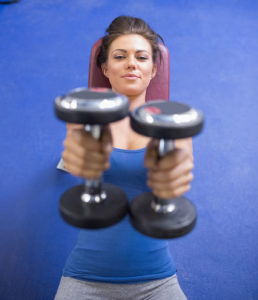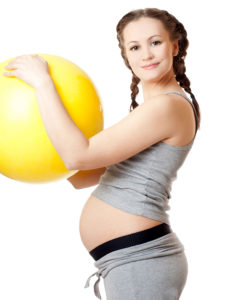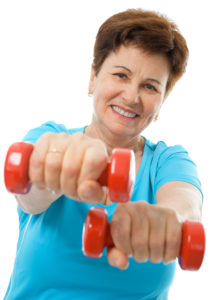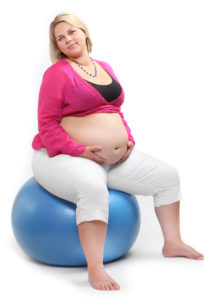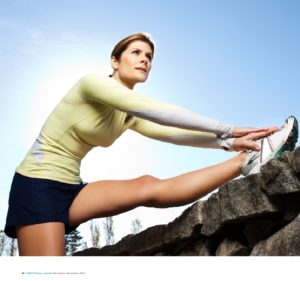Resistance Training Periodization in Women: New Insight for Training Design
Periodization offers a specific strategy for helping women get stronger with resistance training.
It has been well documented that appropriate resistance training can help people across a broad range of ages, fitness levels and health statuses. Resistance training improves muscular strength, muscular endurance and body composition while assisting the body to manage chronic ailments such as diabetes mellitus, obesity, hypertension, bone and joint diseases (osteoporosis and osteoarthritis), and depression (Warburton, Nicol & Bredin 2006).
Another Benefit of Exercising While Pregnant
Pregnant moms interested in giving their unborn babies a mental boost may want to exercise, say research- ers from the University of Montreal.
Weighty Issues for Older Women
Overweight and obesity have a known cor- relation to disability, disease and death. A recent investigation looked at obesity and its impact on women’s survival to 85 years old.
How To Help Middle-Aged Women Improve Body Satisfaction
The percentage of women aged 50 and over who are satisfied with their bodies is quite low, accord- ing to research from the Journal of Women & Aging (2013; 25 [4], 287–304).
The report was based on information from 1,789 women, who reported body-size satisfaction on a figure-rating scale. Only 12.2% of respondents were satisfied with their bodies.
“Satisfied women had a lower body mass index and reported fewer eating disorder symptoms, dieting behaviors, and weight and appearance dis- satisfaction,” the authors reported.
The Exercise–Menopause Connection
Are you in menopause? Then you’re probably familiar with the challenges that many menopausal women experience: hot flashes, night sweats, insomnia, irritability and depression. These symptoms— alone or combined—can compromise a woman’s quality of life. Even worse, menopausal symptoms can create a domino effect. For example, night sweats can cause sleep problems that lead to chronic sleep deficits, which in turn may significantly affect mood, anxiety levels, alertness and mental acuity.
Aerobic Exercise and Strength Training for Older Women: Is There an Optimal Starting Dose?
We have good exercise guidance for fit older adults, but the advice for seniors just starting a fitness program has been less clear.
10 Questions and Answers About Women’s Hormones and Athletic Performance
1. What hormonal changes are observed in boys and girls at puberty?
At puberty, girls develop more adipose tissue, owing to their estrogen levels, and boys develop more muscle mass, owing to their testosterone levels (Isacco, Duché & Boisseau 2012).
2. What is the menstrual cycle, and what are its distinct phases?
Women, Hormones, Metabolism & Energy Expenditure
?When it comes to optimal endurance exercise performance, fuel source and utilization play a major role in success. The contribution and expenditure of fats and carbohydrates for the synthesis of ATP (adenosine triphosphate) during exercise are regulated by several factors, including activity, duration and intensity, as well as the person’s age, training status, diet and gender. Proteins contribute a minor 1%–8% of fuel needs during submaximal exercise (Isacco, Duché & Boisseau 2012).
Optimal Exercise Plan for Women?
There are many different
exercise protocols out there. When it comes to mature women, is there a best plan? New research suggests
there is.
Walking Helps Women, Not Men, Avoid Stroke
In last month’s issue, it was reported that only a small portion of the population walks for extended periods on a regular basis. According to researchers from Spain, women should take up the activity to reduce stroke potential.
Overweight and Obese Women Should Scale Back Weight Gain During Pregnancy
The American College of Obstetricians and Gynecologists has come out with recommendations for weight gain during pregnancy based on the mother’s body mass index and on updated tables from the…
Lack of Sleep, Hunger and Gender
When they don’t get enough sleep, women feel less full and men have a bigger appetite, according to a recent issue of the journal SLEEP. Twenty-seven normal-weight men and women (aged 30–45) were studied under short-sleep (4 hours) and habitual-sleep (9 hours) conditions. After a short night’s sleep, fasting blood samples indicated that fasting and morning ghrelin levels rose in men, while afternoon GLP-1 (glucagon-like peptide) levels fell in women. Sleep duration had no effect on insulin, glucose and leptin profiles.
Fewer, Larger Meals May Be Healthier Option for Obese Women
It may sound counterintuitive, yet new research from the University of Missouri, Columbia, suggests that eating fewer, larger meals may prove healthier for obese women than eating smaller meals more often. More specifically, consuming three substantial meals per day instead of six small meals may decrease obese women’s risk of developing heart disease.
2012 Women’s Health Research Review
Scientists are perpetually uncovering new insights that can help exercise professionals improve the health of female (and male) clients. However, navigating one’s way through research reports can be overwhelming—and often contradictory.
Training Through the Transition
Menopause is different for each woman. Although the average age of natural menopause is 52, some women start the transition as soon as their early 40s. It is estimated that…
Weight Issues Among Older Females
When it comes to eating disorders and body image issues, teenagers or young women might come to mind. However, a new study shows that these problems are also common among older women.
Food Journals Can Help Women Lose Weight
It’s not exactly a new strategy for aiding weight loss, but if you aren’t currently using food journals with clients who are trying to shed pounds, recent research suggests that perhaps you should be. Scientists from the Fred Hutchinson Cancer Research Center summarized the following from their study, which appeared in the July 16 online edition of the Journal of the Academy of Nutrition and Dietetics: women who want to lose weight should faithfully keep a food journal and should avoid skipping meals and eating in restaurants—especially at lunch.
Pregnancy Outcomes Among Obese and Overweight Women
In a study published in the February 20 issue of the Medical Journal of Australia (2012; 196 [3], 184–88), researchers looked at pregnancy outcomes among obese and overweight women.
The scientists analyzed data from 75,432 women who gave birth at the Mater Mothers’ Hospital in Brisbane, Queensland, between January 1998 and December 2009. Approximately 32.7% of the women were classified as overweight or obese. The researchers noticed that women with higher body mass indexes (BMIs)—and their children—tended to have more health-related issues than those with “normal” BMIs.
Church-Held Weight Loss Programs Successful for African American Women
When you’re developing weight loss programs for niche populations, it may be important to understand the role that environment plays in successful outcomes.
One example comes from the Journal of Black Psychology (2012; 38 [1], 81–103). The study’s primary goal was to determine compliance among 55 overweight or obese African American women entering obesity treatment. For 13 weeks, 36 of the women were involved in a program held in churches; the other 19 attended a program in a university setting. Each woman was weighed and completed a physical fitness test.
Exercise = Happiness
When you’re developing weight loss programs for niche populations, it may be important to understand the role that environment plays in successful outcomes. One example comes from the Journal of Black Psychology (2012; 38 [1], 81–103). The study’s primary goal was to determine compliance among 55 overweight or obese African American women entering obesity treatment. For 13 weeks, 36 of the women were involved in a program held in churches; the other 19 attended a program in a university setting.
